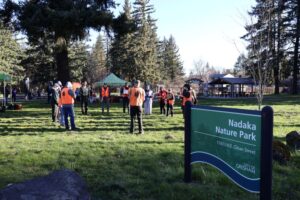Search Results for: climate trees part 1
Climate Trees: Trees for the 21st Century – Part 3
This is the third and final part of our “Climate Trees” series. Read Part 1 and Part 2 here.
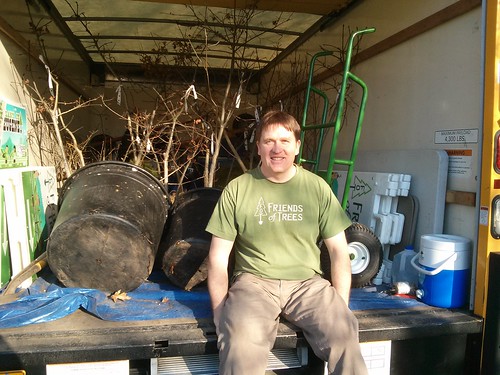
The first of the Tier 2 “climate trees” (California black oak, valley oak, coast live oak, interior live oak, blue oak, and Chinese pistache) were planted at Friends of Trees’ Feb. 9, 2013 planting in Eugene’s Friendly Neighborhood. In the 2013-14 planting season, FOT will increase Tier 2 offerings, adding holly oak, cork oak, canyon live oak, California buckeye, and crape myrtle. On February 24, an arboretum of “climate trees” was planted by the city contractor in the parking lot of Sheldon High School.
Tier 2 trees have been difficult or impossible to source at a reasonable price until now, and there has been little or no local demand for them. FOT is working to improve both the supply of these Tier 1 and Tier 2 trees, and to increase the demand for them through education, outreach and incentives. To increase supply, FOT is talking with nurseries about the potential of these trees, and working on agreements with nurseries to grow the trees locally from appropriate seed sources while minimizing cost and risk to the nurseries.

FOT is also working to identify the provenance or source of all the trees we offer, and to identify appropriate provenance for seed and nursery stock for future trees. The long-term solution to the problem of provenance is to produce trees in local nurseries from diverse, known and well-sourced provenances. FOT has purchased liners (small trees) of several species and entered into relationships with a local nursery to begin growing southwest Oregon and California native trees for street trees for Eugene and Springfield.
We play God with every tree we plant. This imbues our work with responsibility. We are working hard to offer trees that are grown locally with known provenance, are adapted to our climate and soils, and are sited so they can provide beauty and benefits for generations. With your help FOT can build local demand for trees that will thrive in the long run in our cities and build a strong base of skilled, informed consumers, producers and stewards who will tend our trees into the future.
–Burke is Director of FOT Lane County
Climate Trees: Trees for the 21st Century – Part 2
This is a continuation of “Climate Trees: Trees for the 21st Century.” You can read Part 1 here.
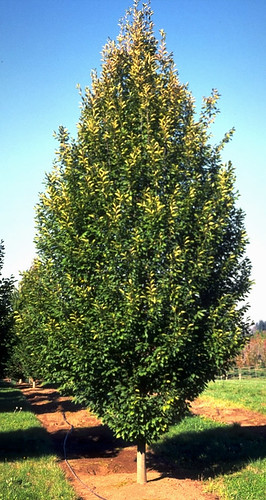
FOT’s Lane County chapter developed a provisional three-tier list of trees that are likely to be resilient to climate change and tolerate heat and drought well to help prioritize planting efforts.
Tier 1 trees are top priority to plant. They are heat and drought tolerant trees that we can plant now, trees already on local approved street tree lists. Of the more than 100 trees on local approved lists, we found 16 trees that we feel are climate resilient, but only four that we can source and receive easy approval to plant locally. These are Oregon white oak, silver linden, red horsechestnut, and European hornbeam. FOT has made major strides at increasing planting of Oregon white oaks on Eugene streets.
Other Tier 1 trees are conifers that local municipalities restrict completely or limit planting to rare 20 foot planting strips, such as Atlas cedar, incense cedar, giant sequoia, deodar cedar, valley ponderosa, and Douglas-fir. Several additional Tier 1 trees are difficult or impossible to source currently, such as sawtooth oak, Hungarian oak, Shumards oak, and burr oak.
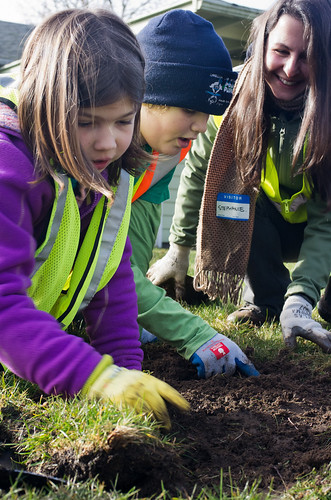
Tier 2 trees are trees that are used as street trees in urban areas in the western US with success are likely to thrive here, but are not on current local approved street tree lists. These include Oregon natives such as California black oak, canyon live oak, Oregon myrtle, and California natives such as coast live oak, interior live oak, blue oak, and valley oak. Other Tier 2 species include chitalpa, crape myrtle, cork oak, holly oak, silverleaf oak, oracle oak, cedar of Lebanon, Spanish fir, Chinese pistache, strawberry tree, and southern live oak.
Tier 3 trees are trees that are rarely or not used as street trees but are heat and drought tolerant and good candidates for experimentation in our area. These include California buckeye, madrone, Japanese chinkapin, Cretan maple, western redbud, and roble beech.
Inspired by FOT’s talks in September 2012, the City of Eugene Office of Sustainability funded two efforts to expand the use of climate resilient trees in Eugene and to create working examples. The Sustainability Office provided funding to FOT to purchase and offer several Tier 2 trees in its Neighborhood Trees program, and to conduct outreach and education efforts about these trees. FOT is currently offering California black oak, valley oak, coast live oak, interior live oak, blue oak, and Chinese pistache.
Click here to read Part 3 of the Climate Tree series.
–Burke is Director of FOT Lane County
Climate Trees: Trees for the 21st Century – Part 1
By Erik Burke
This is the first in a three-part series about Friends of Trees’ new Climate Tree Program, initiated in the Eugene-Springfield area during the 2012-13 planting season.
The times they are a changing—for people and trees. Humans are changing the earth’s climate, and many of the trees we plant in our cities are unlikely to fare well in these changing conditions.
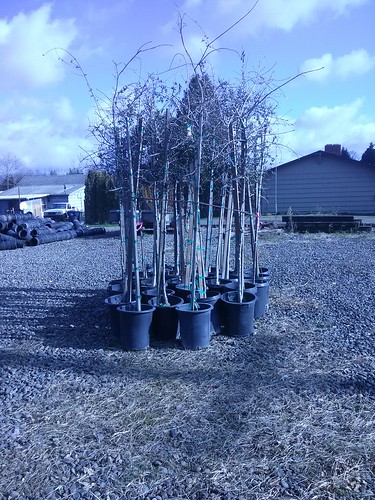
It’s not clear how climate will change in western Oregon. It’s very likely that there will be significant changes in temperature and precipitation, with temperature perhaps rising over the next 40-50 years so that temperature in Eugene-Springfield is similar to areas in northern California.
Changes in precipitation are less clear, as is whether we will see radical changes in ocean currents or the eastern Pacific high pressure system that gives us our annual summer drought. Cities like Chicago are changing the trees they plant in public areas, replacing the trees they have been planting with trees from warmer climates around 500 miles south.
To begin to address these issues, on September 14, 2012, Friends of Trees organized two talks on the topic of “Trees for Eugene-Springfield’s 21st Century Urban Forest.” I presented an initial tree list developed locally to guide species selection. This discussion of trees for the 21st Century is not solely about climate-resilient trees. It is also about shifting the approach to planting trees from an emphasis on ornament and profit, to an emphasis on trees that are more resilient and locally adapted, and provide more ecological services than many currently planted species.
FOT Neighborhood Trees Senior Specialist Kris Day, from FOT’s Portland office, and Jim Gersbach, longtime Friends of Trees volunteer, gave presentations on their work to identify drought-tolerant trees that thrive in our area, plant them, and monitor their success over time. Kris and Jim are part of a Portland-based project called Tomorrow’s Urban Forest (TUF) whose goal is to develop a better understanding of which species of trees are likely to thrive and which are likely to struggle in the Willamette Valley given a warmer and possibly drier future climate.
A major factor for tree selection in the Eugene-Springfield area is the area’s annual summer drought. Significant rainfall rarely occurs locally from late May through September, limiting which trees thrive here without irrigation.
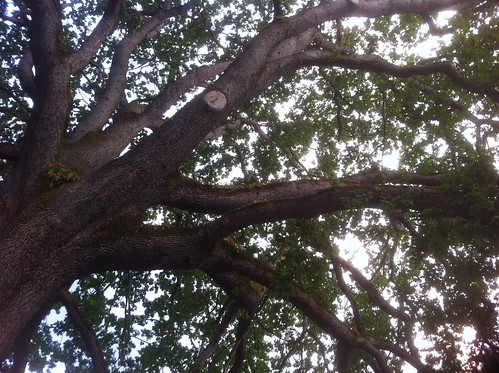
Tree assemblages of the warm period in the area’s history, from 6-10,000 years ago, such as Oregon white oak, valley ponderosa, and incense cedar, are likely to be particularly suited to our area in the 21st century. Trees from northern California are likely to be heat and drought tolerant in our area. Trees from other regions with similar summer dry climate patterns to ours are more likely to thrive in our area than trees from summer wet areas. This means that the best regions to choose trees from that are likely to thrive in our cities are western North America, southern Europe, north Africa, southwestern Australia, and south-central South America.
Given these facts, FOT Lane County developed a provisional three-tier list of trees that are likely to be resilient to climate change and tolerate heat and drought well to help prioritize planting efforts.
Click here to read Part 2 of the Climate Trees series.
–Burke is Director of FOT Lane County
Friends of Trees, Friends of Bees
How we can plant to promote native pollinators
Next time you see a bee buzzing around your garden, take a closer look. It’s cute, right? And on top of that, it’s performing a very important ecological process—pollination!
Last month we hosted two pollinator workshops in Washington county during National Pollinator Week, thanks to funding from the Tualatin Soil and Water Conservation District. Folks gathered at the PCC Rock Creek Learning Garden and at Tualatin River National Wildlife Refuge to take a tour of pollinator-friendly plants, learn what makes for good pollinator habitat, and to spot some native bees along the way. Friends of Trees staff shared their knowledge on the topic and led activities to guide people in designing their own pollinator gardens.
What is a pollinator? Pollinators are animals (mostly insects) that move pollen from a flower’s male part to its female part in their search for sustenance, making that plant’s reproduction possible. This process makes pollinators a really key part of both agricultural and ecological systems. 35% of our food sources and 75% of flowering plants depend on pollinators.
“Unfortunately, we’re seeing a massive, unprecedented decline in native bees and other pollinators,” says Thomas Meinzen, a Neighborhood Trees Specialist at Friend of Trees who studied pollinator ecology and conservation in graduate school. In some countries, studies have shown more than 75% decline in insect biomass in 30 years. Because pollinators are relatively understudied, the impacts and ramifications of this decline are not fully understood.
“There are a lot of contributing factors, including pesticide and herbicide use, grazing practices, agricultural monocultures, habitat loss and climate change,” Thomas says. “It’s scary, but there are still things we can do.”

IN OUR OWN BACKYARDS
We can create habitat in our own backyards and parks. Luckily, we don’t need entire wilderness areas for pollinators to live in. You can help by planting a variety of flowering plants to provide food for pollinators from spring all the way into fall.
“Trees are particularly helpful here because they flower earlier in the year than most smaller flowering plants, providing food for early-season pollinators like bumble bees,” Thomas says. “Trees like California buckeye, cascara, hawthorns, willows, and fruit trees are all great options for native pollinators.”
It’s also best to cultivate a diversity of flower shapes, colors, and types to attract a diverse array of pollinators. Bees, butterflies, and flies are all pollinating insects looking for different types of food.
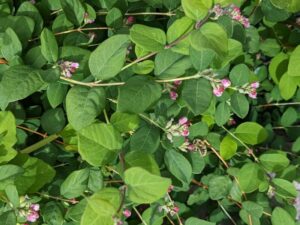
NATIVE PLANTS FOR NATIVE POLLINATORS
It makes sense that native pollinators are attracted to native plants. Our Green Space program enhances natural areas by planting many thousands of native shrubs and plants each planting season, improving air and water quality and creating habitat for wildlife, including pollinators.
“A lot of our Green Space plantings are designed to improve water quality in particular,” says Kaitie, a Green Space specialist. “But these plants are great for pollinators, which is more than just an added bonus.”
Plants like red-flowering currant and Oregon grape are common at our Green Space plantings and favorites for pollinators. Our Green Space plantings also leave open ground where bees can nest.
Many people express concern for honeybees, not realizing that honeybees come from Europe and can potentially outcompete native bee species. There are over 4,000 native bee species in the United States and over 650 in Oregon.
“There’s a lot of growing interest in pollinators,” Thomas says. “It was exciting to see that at our pollinator workshops with great turnout, in-depth conversations, and the chance to send folks home with pollinator plants.”
The best things we can do to protect and promote native pollinators are to avoid using pesticides and herbicides on our properties, plant flowers and native plants, and leave things a little messy so that pollinators can make themselves at home in our gardens.
A Memorial for Lives Lost in the 2021 Heat Dome
72 trees planted for 72 lives lost in Multnomah County
On March 16th at Nadaka Nature Park in Gresham, dozens of volunteers gathered on an especially gorgeous morning, eager to plant trees. While all of our events are climate action, this one had particular significance. All of these new community trees will serve as memorial to the lives lost to the 2021 Heat Dome. The Arbor Day Foundation funded the planting of 50 yard trees in addition to the 72 memorial street trees, providing much needed shade to these neighborhoods.
“The 2021 heat dome has brought us into stark understanding of the vulnerabilities of our neighborhoods, where the shade of trees is a precious resource,” says Yashar Vasef, Executive Director for Friends of Trees.
It’s been nearly three years since that historic heat wave with temperatures as high as 119 degrees Fahrenheit, but for many the memory is still fresh. Several families who lost loved ones during the heat dome joined the volunteers at Nadaka to mark the occasion with intentionality and reflect on the purpose of the planting event. The morning was not a somber one, because, as Multnomah County Chair Jessica Vega Pederson put it in her remarks, “planting a tree is a hopeful act.”
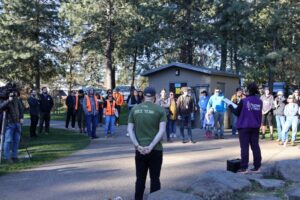
As summer approaches, and with it a chance for another heat wave, it’s important to remember both short and long-term preparedness. We must protect the trees we have, and continue to grow our canopy, especially in neighborhoods that are designated as heat islands.
“In the face of such tragedies, it is imperative that we act decisively on the things we can control,” Yashar says. “Our efforts to plant trees are a stance against the worst outcomes of climate change.”
After remarks from leaders, crews of volunteers headed out into East County neighborhoods to plant street and yard trees that will shade the community. And family members gathered to plant an American hornbeam at Nadaka Nature Park in memory of their loved ones. One family member said they plan to return to the park each year for a family barbecue and to visit and care for the memorial tree.
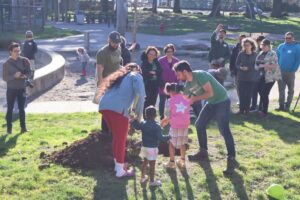
“Each tree we planted helps build a shield against the worst humanitarian impacts of extreme heat,” Yashar says, “and serves as a testament to our shared commitment to building a safer, more resilient community.”
***
The memorial planting event was organized by Friends of Trees, Multnomah County, and the City of Gresham.


